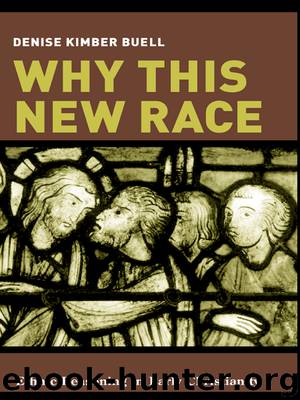Why This New Race by Buell Denise;

Author:Buell, Denise;
Language: eng
Format: epub
Tags: REL015000, Religion/Christianity/History, REL108020, Religion/Christian Church/History
Publisher: Columbia University Press
Published: 2005-08-02T16:00:00+00:00
Becoming: The Gospel of Philip’s Message of Transformation
The Gospel of Philip is a collection of short teachings and sayings of Jesus that are not placed within a narrative structure. That is, it is structurally more like the Gospel of Thomas than it is like the canonical narrative gospels.35 Although difficult to interpret given its lack of continuous narrative, many of its small units concern themselves with the transformations entailed in becoming and being an insider, often within the context of ritual practices: “Acquiring rebirth, the Name of God, and resurrection through the baptismal and anointing ceremonies is the beginning of the initiate’s transformative experiences.”36 If anything holds this wide-ranging collection of materials together, it is the theme of progressive transformation. Ethnoracial language is among the wide array of ways of marking differences among humans (and human distinctiveness from other kinds of beings).37
Christianness and salvation are not only portrayed in and through change (the individual must undergo profound transformation to become a Christian, Christ, bridegroom, or perfect) but also through stability or essence. That is, the fluidity of identity that the text communicates in passages about ritual, language, and salvation history is grounded in the notion that there are different kinds of beings (for example, humans versus animals; living versus dead; slave versus free, child versus adult; Christian versus Hebrew; or Roman, Greek, Jew, barbarian, and Christian; God versus “ruling powers”).38
The terms of group identification that appear in the Gospel of Philip, such as “Christian,” “apostle,” “perfect,” “Hebrew,” “Jew,” and “gentile” are not static.39 I mean this in two senses: they have different rhetorical functions in different units,40 and most contexts also stress or imply that none of these categories is fixed. Despite the different sources from which the material in the Gospel of Philip is drawn,41 the passages that employ such terminology function to reinforce persistent themes of progressive transformation accomplished by faith, ritual action, ingestion, and visual perception.
Transformation of one’s mode of existence is a thematic concern that permeates the entire Gospel. The Gospel of Philip uses the juxtaposition between fixed and fluid throughout to exhort its readers to change and to destabilize apparent ontological antitheses while also proclaiming the fundamental reality of both the Pleroma and the ideal form of being.42 By juxtaposing materials drawn from a number of early Christian perspectives that articulate available modes of existence and the relationship between them in different ways, the Gospel produces powerful yet unstable readings of the simultaneously fixed and fluid character of humanity.
The non-narrative character of the Gospel of Philip enhances the force of this double-sided perspective, as the opening of the Gospel vividly shows:
Download
This site does not store any files on its server. We only index and link to content provided by other sites. Please contact the content providers to delete copyright contents if any and email us, we'll remove relevant links or contents immediately.
The Art of Boudoir Photography: How to Create Stunning Photographs of Women by Christa Meola(18437)
Red Sparrow by Jason Matthews(5273)
Harry Potter 02 & The Chamber Of Secrets (Illustrated) by J.K. Rowling(3578)
In a Sunburned Country by Bill Bryson(3411)
Drawing Cutting Edge Anatomy by Christopher Hart(3358)
Figure Drawing for Artists by Steve Huston(3315)
Harry Potter and the Prisoner of Azkaban (Book 3) by J. K. Rowling(3181)
The Daily Stoic by Holiday Ryan & Hanselman Stephen(3152)
Japanese Design by Patricia J. Graham(3037)
The Roots of Romanticism (Second Edition) by Berlin Isaiah Hardy Henry Gray John(2837)
Make Comics Like the Pros by Greg Pak(2794)
Stacked Decks by The Rotenberg Collection(2729)
Harry Potter and the Deathly Hallows (7) by J.K. Rowling(2581)
Draw-A-Saurus by James Silvani(2567)
Tattoo Art by Doralba Picerno(2532)
On Photography by Susan Sontag(2511)
Churchill by Paul Johnson(2415)
Foreign Devils on the Silk Road: The Search for the Lost Treasures of Central Asia by Peter Hopkirk(2396)
The Daily Stoic by Ryan Holiday & Stephen Hanselman(2390)
